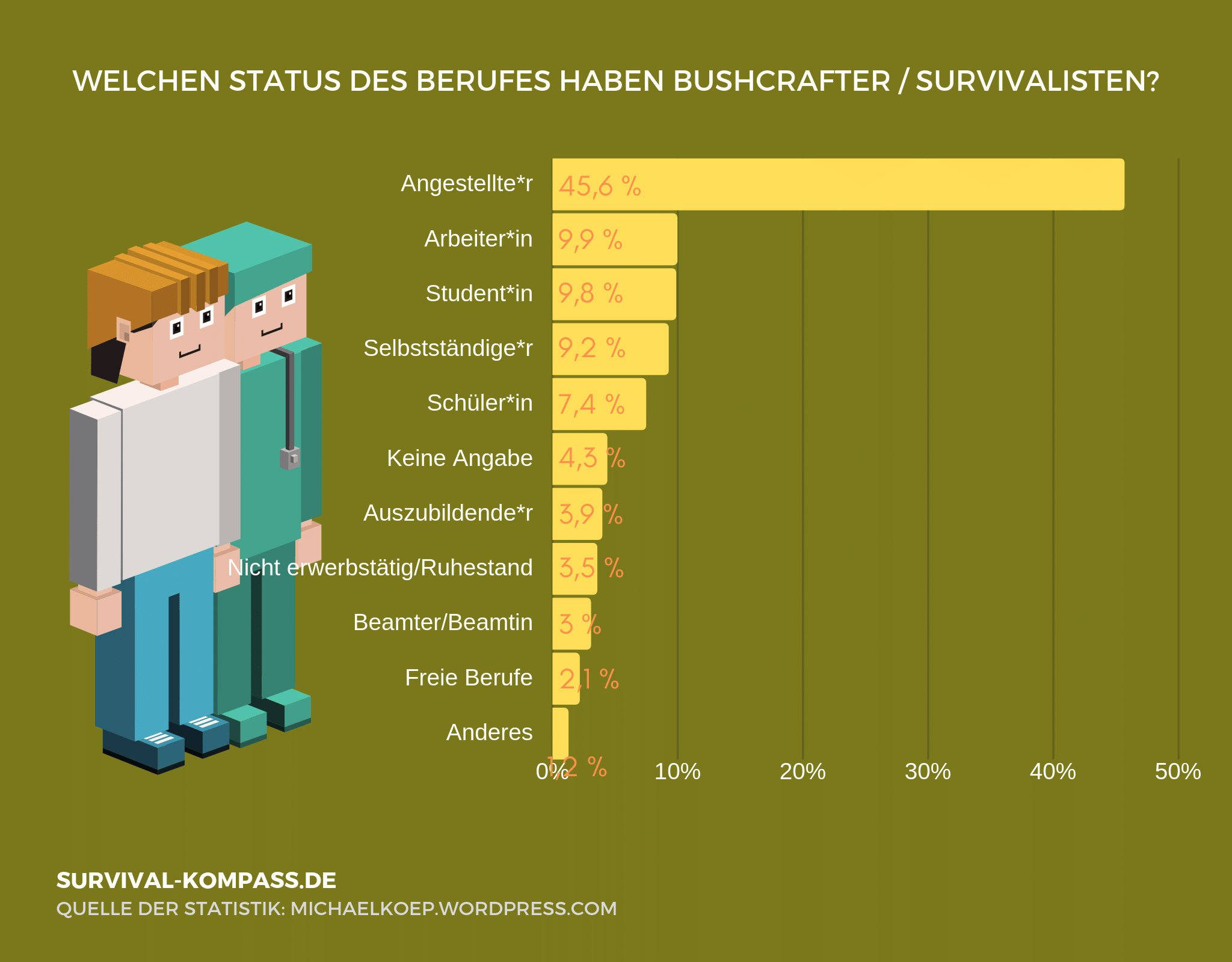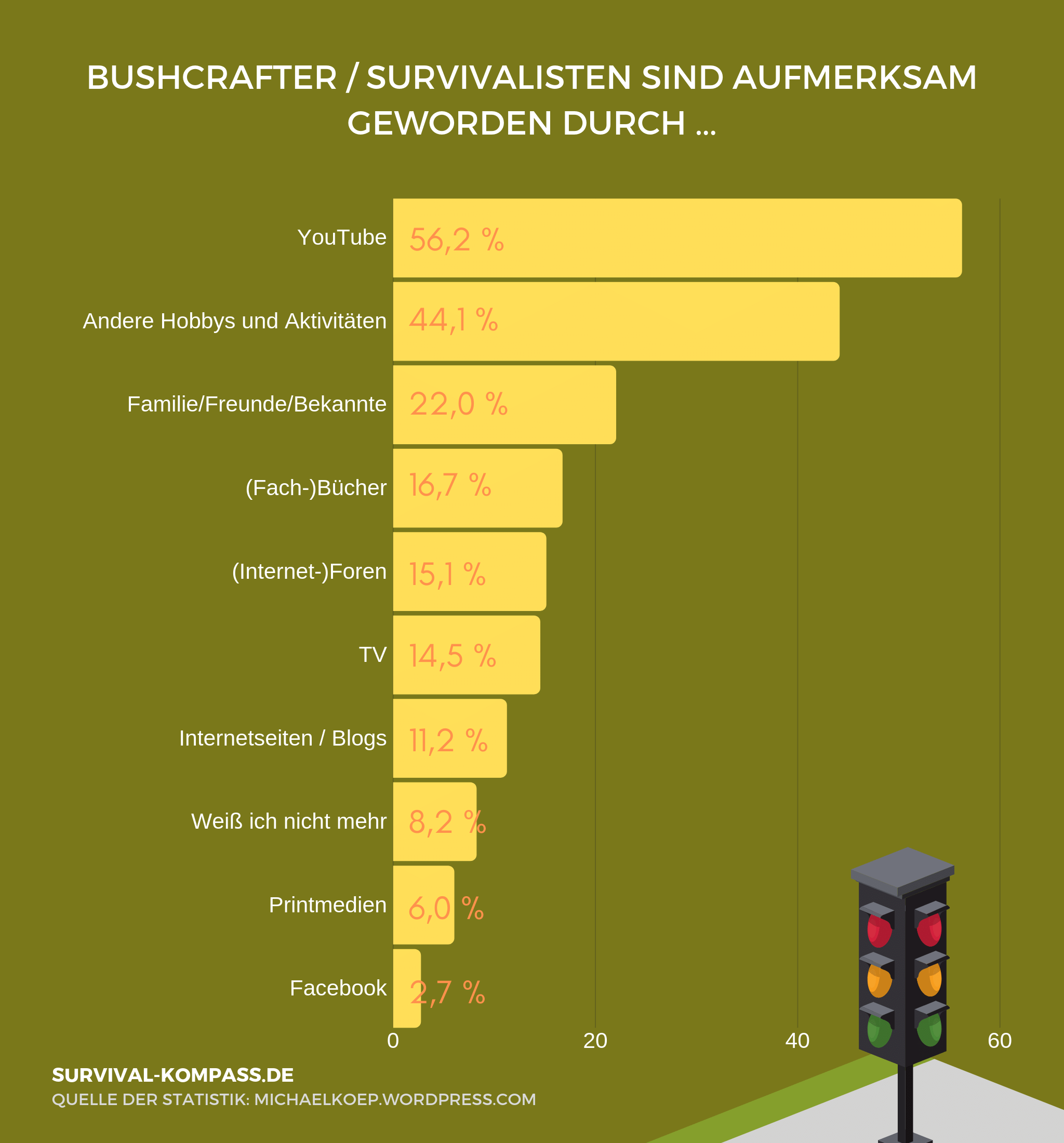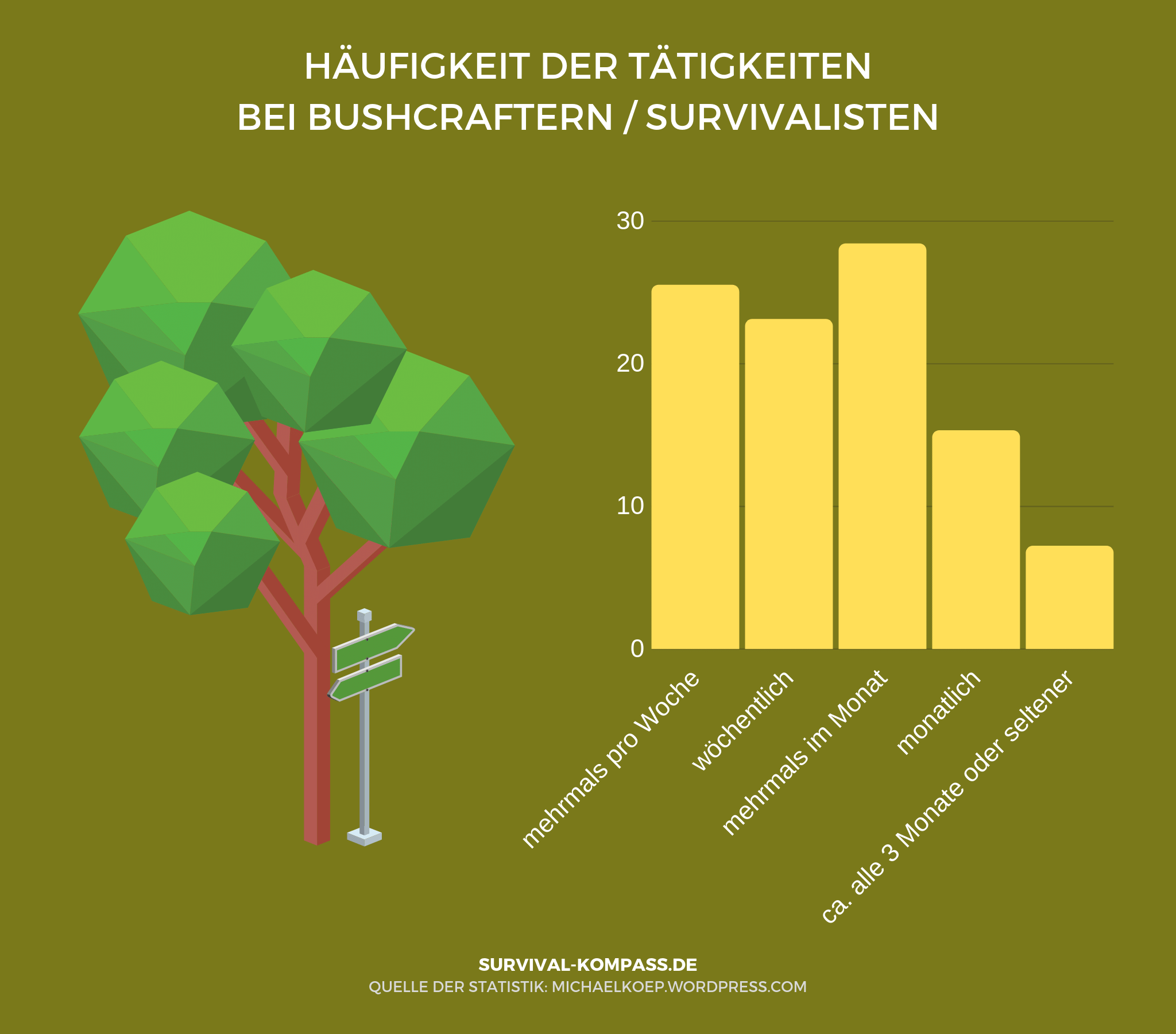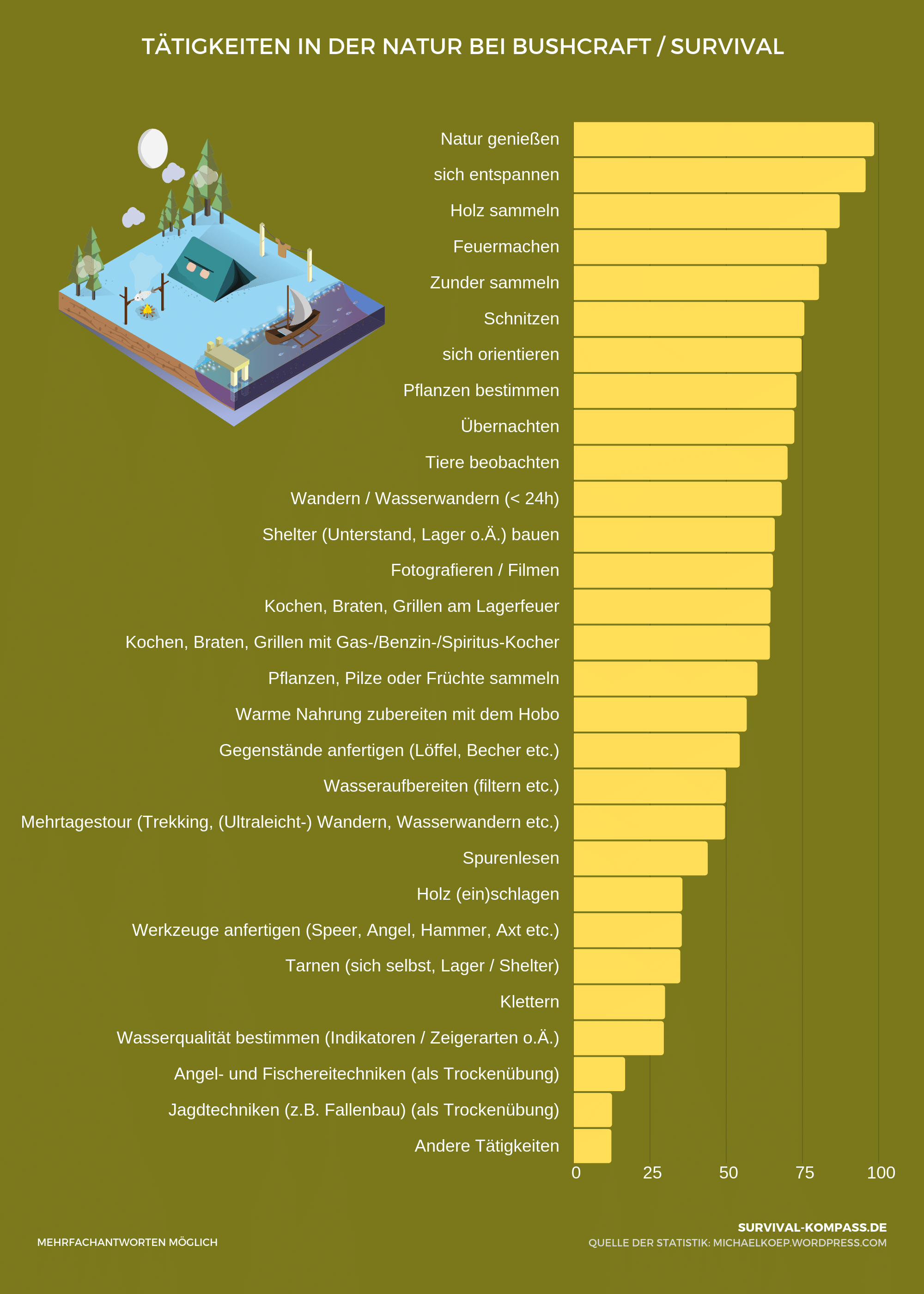Data and facts about Bushcrafters and survivalists in Germany
Great data and facts about bushcraft & survival from Germany. Most are male, on average 35 years old, and live in the west/south.


From Martin Gebhardt. Check out my “About me” page.
👉 The key facts from this guide
- The majority of bushcrafters and survivalists in Germany are male and average 35 years old.
- Most bushcrafters and survivalists live in North Rhine-Westphalia, Baden-Württemberg and Bavaria.
- The main motivations for bushcraft and survival are experiencing nature, relaxation, fun and a balance to everyday life.
- Most bushcrafters and survivalists have not participated in any professional training, but 16.8% intend to do so.
- Most bushcrafters and survivalists pursue their activities alone and spend an average of 10.2 hours per stay in nature.
- Most conflicts arise from unauthorized campfires, fishing, camping and overnight stays, and most bushcrafters and survivalists seek conversation as a solution.
Today I want to show you great facts about Bushcraft and Survival. The results come from the master's thesis of Michael Koep.
The survey was about the motivation, attitude, and activities in nature of Bushcrafters and survivalists. There were 564 data sets, on which the results are based.
Overall, 94.5% of men and 4.3% of women participated in the survey. 0.4% chose a third gender ("other") and the rest did not provide information about their gender.
The respondents are on average 35.7 years old. The entire range extends from 12 to 70 years.

Many of the respondents classified themselves as Bushcrafters (60.1%) and survivalists (13.7%). However, 26.2% also stated that they classify themselves in other categories. These are:
- Forest walkers
- Hikers
- Trekking enthusiasts
- Nature lovers and nature enthusiasts
- Preppers and survivalists
- Wilderness education
Let's now go into detail. First, let's take a look at where the most and least Bushcrafters/survivalists live in Germany.
Residences (Federal States) of Bushcrafters / Survivalists
Main statements:
Most Bushcrafters/survivalists live in:
- North Rhine-Westphalia: 21.5%
- Baden-Württemberg: 17%
- Bavaria: 16.1%
The fewest Bushcrafters/survivalists live in:
- Mecklenburg-Western Pomerania: 1.1%
- Saxony-Anhalt: 0.9%
- Bremen: 0.4%

Child status among Bushcrafters / Survivalists
Main message: Most Bushcrafters and survivalists do not have children.

Education level of Bushcrafters and Survivalists
Main message: More than half of Bushcrafters and survivalists have a high level of education.

Occupational status of Bushcrafters and Survivalists
Main message: Most Bushcrafters and survivalists are employees.

Motivation of Bushcrafters and Survivalists - what drives them?
It is clear to see that most people practice Bushcraft / Survival for the following reasons:
- Experience nature
- Find relaxation and peace
- Have fun
- To have a balance to everyday life and to escape from it
- To feel free
Next comes the important part of training, practicing, and learning knowledge, techniques, and skills.
The survey was closed and multiple answers were possible.

Introduction to Bushcraft and Survival
How did the participants become aware of bushcraft and survival? What motivated them to start engaging in these activities?
At the very top is the video platform "YouTube" and "Other hobbies or activities".
Under "Other hobbies or activities" the following activities are meant:
- Trekking, hiking, climbing, camping, hunting, fishing, and more: 60.2%
- including:
- practicing old craft techniques such as bow and knife making
- Reenactment
- putting together optimal equipment
- collecting knives
- martial arts
- Prepping
- military
- own profession
- interest and connection to nature
- including:
- Childhood and youth activities: 39%

Participation in (professional) bushcraft or survival trainings
Most Bushcrafters and survivalists have not participated in any training.
Interesting is the result of whether the participants still want to participate in such training. 16.8% intend to do so.

Self-Assessment
Most Bushcrafters and survivalists consider themselves to be between beginner and expert. This means that they have basic knowledge, which can be expanded upon.

Frequency of Activities
Approximately 25.6% of Bushcrafters and survivalists engage in their activities multiple times a week. 23.2% go out once a week and 28.5% pursue their hobby multiple times a month.
Only 15.4% practice Bushcraft/Survival once a month and only 7.3% go approximately every 3 months or less frequently.

Duration of Activities
On average, Bushcrafters/survivalists spend 10.2 hours per stay in nature.
However, 50% do not spend more than 5 hours and 25% not more than 3.5 hours there.

Individual or collective exercise of activities?
Most Bushcrafters and survivalists pursue their activities alone. Thereafter, come their partners and colleagues.
My tip for finding partners: use our Companion Search! With the Companion Search from Survival-Kompass, you can find partners for your next adventure.

Activities in nature
The results of the activities carried out in nature are particularly magnificent, in my opinion.
Here it becomes clear that most Bushcrafters/survivalists primarily want to be in nature and work with wood.
Fire making and collecting tinder is also an important aspect of the activities. This is not surprising because fire making and collecting tinder means warmth, protection, safety, and food.

Reading tips on collecting wood, making fire, tinder, and carving:
- Can I collect branches and wood in the forest? (for firewood, building wood, carving wood)
- How do I start a fire? [10 steps to success]
- Survival basics: Collecting and making tinder [22 examples]
- Carving a wooden spoon: how to get started and what you need (basics)
Relationship with Owners and Managers
A big topic among Bushcrafters and survivalists is often the legal situation. Is it allowed to sleep in the forest? Is it allowed to make a fire in the forest? Is it allowed to collect sticks?
The problem that arises is that all forests and meadows belong to someone. In the article "Is Bushcraft legal? [Fire, Camping, Camps, Hunting, Fishing]" you will learn much more about it.
Accordingly, it is interesting to learn how the respective participants deal with the legal situation.
Here are the main statements:
- 64% know who owns the area or who is responsible for it
- 34% were approached about their activities in nature
- 18% have permission from the owners/responsible parties to pursue their activities in the area
- 13% of respondents are even owners of the area
- 1% were denied permission when they asked for it
That means asking for permission is seldom denied. So, it's worth getting permission from the authorities or from the owners!

Multiple answers were possible for this question.
Conflict situations and participants
Bushcrafters and survivalists occasionally have conflicts with law enforcement officers, such as hunters or foresters.
Mainly conflicts arise from unauthorized making fire, fishing, camping and overnight stays.

Most Bushcrafters and survivalists seek conversation as a solution to conflicts.
They try it with the following contents:
- Explain your motivation
- Describe the activities you have carried out
- Show responsibility
- Explain your knowledge
Most Bushcrafters and survivalists proceed as follows:
- They remain calm
- Appease
- Are honest / show themselves openly
- Communicate in a friendly way
Many Bushcrafters and survivalists also wish for this approach from their counterparts. They find communication on equal footing important, as well as understanding and acceptance of their activities.
If a conflict could not be resolved, it usually led to the following requests:
- Stop activity
- Leaving the area
- Avoid the area in the future
Only in very few cases did a fine have to be paid. Usually, it remained with a lecture by the supervisor or the location had to be relocated.
Meaning of Nature
The last point is one of the most essential for me and supports my thesis that Bushcrafters and Survivalists are nature lovers.
I believe that we as Bushcrafters and survivalists are not machos. We do not have to fight against nature, but rather live harmonizing with it more than many other people. And we have a high awareness of nature conservation and environmental pollution.
But let's take a look at the evaluation of the survey. What do the numbers say:
- 99% say that nature is essential for a good life
- Everyone is happy when they can be in nature
I find the comparison to the Nature Awareness Study from 2015 particularly interesting. The Nature Awareness Study is a German population survey on nature and biological diversity.
I can already reveal the main statements: Bushcrafters and survivalists have approval ratings above the national average!
Take a look at the graphic:

Summary
The master thesis by Michael Koep provides great insights into the topic of bushcraft and survival.
Let's get straight to the point:
- Most Bushcrafters and survivalists are male and on average 35 years old
- They are spread throughout Germany, but mainly in the south and west
- Many have a medium to high level of education
- Most are employed in a company
- They want to experience nature, seek relaxation and escape from everyday life
- Most rate themselves with a medium level of expertise
- Most Bushcrafters and survivalists pursue their activities alone
- Working with wood and making fire are at the top of the list of activities
- Most Bushcrafters and survivalists seek conversation as a solution to conflicts
- Bushcrafters/survivalists have a high awareness of nature conservation and environmental pollution (higher than the national average)
And one more note: the survey is not statistically representative.
What do you think of the data and facts? Do you recognize yourself in the evaluation and survey?
Write your opinion in the comments below!


Author of the guide
Martin Gebhardt
Hey, I'm Martin. On my blog, you will learn the basics and numerous details about living in the wild. I think survival, bushcraft and the good life in nature are the keys to happiness. Find me here on Instagram or on YouTube. You can find more about my mission on the About Me page.
Was this guide helpful?
11 people found this guide helpful.
5.00 out of 5 points (11 Ratings)
Comments (0)
This post may contain affiliate links. So if you click on the links and make a purchase, I will receive a small commission at no additional cost to you. Click here, to learn more about it.



